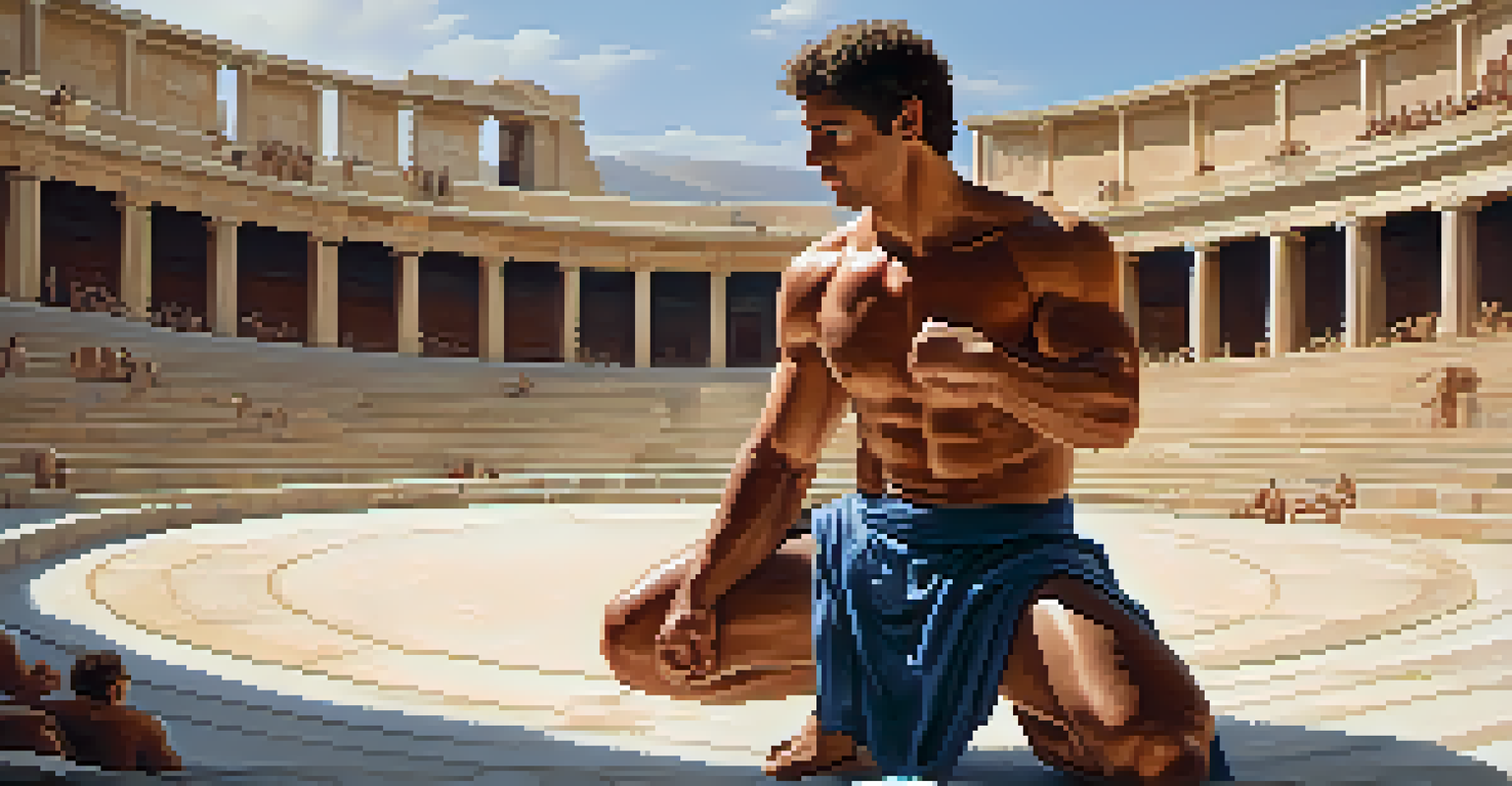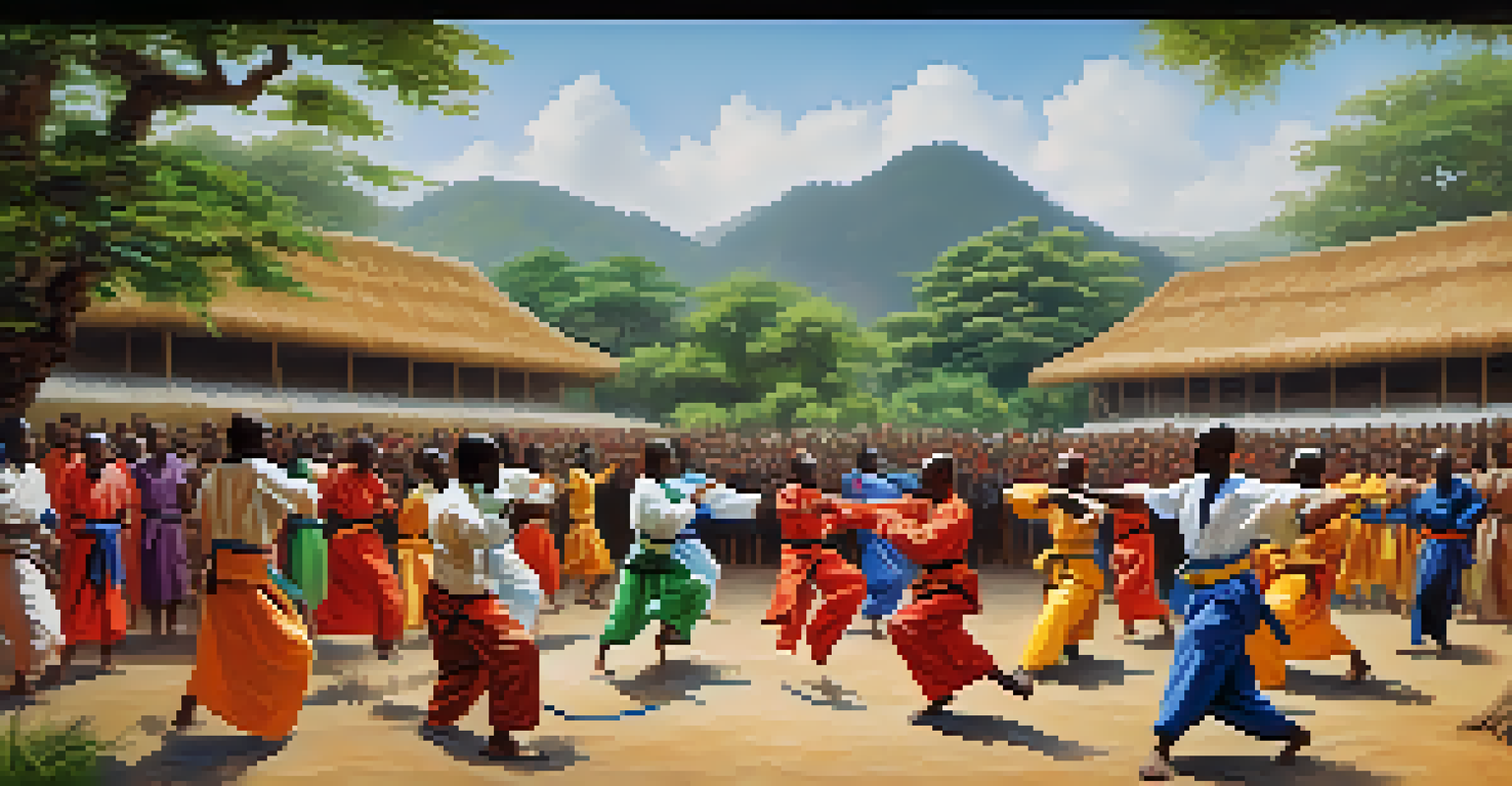Martial Arts in Ancient Civilizations: A Comparative Study

Introduction to Martial Arts in Ancient Civilizations
Martial arts have a rich history that dates back to ancient civilizations, serving as a vital aspect of culture and warfare. Various societies developed their own unique fighting techniques, reflecting their values and needs. From the disciplined training of the samurai in Japan to the strategic maneuvers of ancient Greek warriors, martial arts were much more than mere combat; they embodied philosophy and tradition.
Martial arts are not just about fighting; they are a way of life, a path to personal growth and self-discovery.
These martial disciplines were often influenced by the environment, societal structure, and even religious beliefs of the civilizations. For instance, in China, martial arts were intertwined with spiritual practices, emphasizing harmony and balance. This complexity makes the study of ancient martial arts not only fascinating but also essential for understanding the societies that practiced them.
In this article, we will explore the martial arts of various ancient cultures, comparing their techniques, philosophies, and historical significance. Through this comparative lens, we can appreciate the diversity of martial practices and the common threads that link them across time and geography.
Martial Arts in Ancient China: The Birth of Kung Fu
Ancient China is often heralded as the birthplace of martial arts, particularly with the development of Kung Fu. This term encompasses a variety of fighting styles, each with its own techniques and philosophies. One of the foundational aspects of Kung Fu is its integration with Chinese philosophy, such as Confucianism and Taoism, emphasizing discipline, respect, and personal growth.

Kung Fu practitioners often trained in natural settings, drawing inspiration from animals and nature, which influenced their movements and techniques. For example, the fluidity of the snake and the power of the tiger are reflected in specific styles. This connection to nature not only enhances the physical practice but also fosters a deeper understanding of life and balance.
Martial Arts and Cultural Identity
Martial arts across ancient civilizations reflect the cultural values, philosophies, and social structures of their societies.
The historical significance of Kung Fu extends beyond combat; it was also a means of self-cultivation and community bonding. Monasteries, like the Shaolin Temple, became centers for training and spiritual development, where martial arts were practiced as a way to achieve enlightenment. This holistic approach set the stage for martial arts philosophy that would resonate through generations.
Ancient Greece: Pankration and Athleticism
In ancient Greece, martial arts took on a different flavor with the emergence of Pankration, a no-holds-barred combat sport that combined boxing and wrestling. This form of martial arts was part of the Olympic Games, showcasing the Greeks' appreciation for athletic prowess and physical skill. Pankration was not just about brute strength; it required strategy and technique to outmaneuver opponents.
The ultimate aim of martial arts is not having to use them. It is about cultivating the mind and spirit.
The Greeks valued the ideals of arete, or excellence, and kalokagathia, the harmony of body and mind, which were central to their martial training. Athletes underwent rigorous training regimes, often starting at a young age, to prepare for competitions. This emphasis on physical fitness and mental fortitude contributed to the development of a warrior culture in ancient Greece.
Further, Pankration served as a means of settling disputes and gaining social status. Victorious fighters enjoyed fame and respect, illustrating how martial arts were embedded in the social fabric of Greek life. The influence of Pankration can still be seen today in modern mixed martial arts, showcasing its lasting legacy.
The Samurai and Bushido: Martial Arts in Feudal Japan
In feudal Japan, the samurai were not only warriors but also practitioners of a unique martial art governed by the code of Bushido. This code emphasized loyalty, honor, and discipline, shaping the samurai's approach to combat. Techniques such as Kenjutsu (sword fighting) and Iaijutsu (drawing the sword) were meticulously developed, reflecting the samurai's commitment to their craft.
Training was rigorous and included not only physical conditioning but also mental and spiritual preparation. Samurai were expected to cultivate virtues like courage and respect, which were essential for their roles as both warriors and leaders. This holistic approach elevated martial arts to a way of life, influencing Japanese culture profoundly.
Holistic Approach to Training
Many martial arts integrate physical combat with mental and spiritual disciplines, promoting personal growth and community bonding.
The samurai's legacy continues to resonate in modern martial arts practices, emphasizing respect and discipline. The aesthetics of Japanese martial arts, including forms and rituals, showcase a deep appreciation for tradition and history, making them a significant part of Japan's cultural identity.
The Role of Martial Arts in Ancient India: Kalaripayattu
In ancient India, Kalaripayattu emerged as one of the oldest martial arts, rooted in both physical combat and traditional healing practices. Originating in the southern state of Kerala, this art form combines strikes, grappling, and weaponry, showcasing a comprehensive approach to martial training. Kalaripayattu's techniques are often inspired by animal movements, similar to other ancient martial arts.
Beyond combat, Kalaripayattu incorporates elements of yoga and meditation, emphasizing the connection between body and mind. This integration fosters not only physical strength but also mental clarity and emotional balance. Practitioners often engage in rigorous training that includes flexibility, endurance, and focus.
Kalaripayattu is also steeped in folklore and spirituality, often intertwined with local myths and legends. This cultural richness adds depth to its practice, making it more than just a fighting style but a celebration of heritage and identity. The revival of Kalaripayattu in contemporary times highlights its enduring significance in Indian culture.
African Martial Arts: A Diverse Heritage
Africa boasts a myriad of martial arts styles, each reflecting the continent's diverse cultures and histories. Techniques such as Capoeira from Brazil, which has roots in African traditions, showcase the blend of dance and combat. In various regions, martial arts were often practiced as a means of self-defense and community building, enriching local traditions.
Many African martial arts incorporate elements of ritual and community participation, transforming training into a social event. For example, in several West African communities, martial arts training is often accompanied by music and dance, creating a vibrant atmosphere. This communal aspect fosters unity and strengthens cultural identity.
Legacy of Ancient Practices
The principles and philosophies of ancient martial arts continue to influence modern practices, emphasizing discipline and respect.
The significance of African martial arts extends beyond combat; they serve as a form of storytelling, passing down traditions and values through generations. As we explore the rich tapestry of African martial arts, we can appreciate their role in shaping community dynamics and preserving cultural heritage.
Comparative Insights: Common Themes Across Cultures
As we compare martial arts across ancient civilizations, several common themes emerge, highlighting the universal appeal of these practices. A shared emphasis on discipline, respect, and personal growth is evident in each culture's approach to martial training. Whether through the structured techniques of Kung Fu or the spirited competition of Pankration, martial arts serve as a path to self-improvement.
Additionally, martial arts often reflect the cultural values and philosophies of their respective societies. For example, the spiritual undertones of Kalaripayattu resonate with the holistic wellness practices in Indian culture, while the honor-driven ethos of Bushido mirrors the samurai's role in society. These connections illustrate how martial arts are intertwined with the very fabric of cultural identity.

Moreover, the communal aspects of martial arts training foster social bonds and cultural preservation. From the rituals in African combat traditions to the training regimens of ancient Greece, these practices not only prepared individuals for combat but also reinforced community ties. This comparative study reveals that, regardless of the era or location, martial arts have consistently been a vital means of expressing cultural identity and fostering community.
Conclusion: The Legacy of Ancient Martial Arts
The exploration of martial arts in ancient civilizations reveals a rich tapestry of history, philosophy, and culture. Each martial discipline offers unique insights into the societies that created them, showcasing their values, struggles, and aspirations. As we reflect on these practices, it's clear that martial arts have transcended their original purpose, becoming symbols of identity and resilience.
Today, the legacy of ancient martial arts continues to influence modern practices, reminding us of the importance of discipline, respect, and community. Martial arts are not only about physical prowess but also about cultivating a mindset that values growth and harmony. This holistic perspective is what keeps these traditions alive, resonating with practitioners worldwide.
By studying the martial arts of ancient civilizations, we gain a greater appreciation for their significance beyond combat. They teach us valuable lessons about life, culture, and the human experience, demonstrating that the essence of martial arts is as relevant today as it was centuries ago.